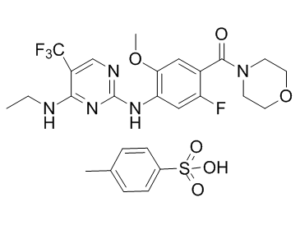GNE-7915 tosylate is a novel, highly potent, selective, and brain-penetrant leucine-rich repeat kinase 2 (LRRK2) inhibitor, with IC50 and Ki of 9 nM and 1 nM, respectively. GEN-7915 has been shown to induce dephosphorylation of LRRK2 in the brain of transgenic mice. GNE-7915 is not reported to cause cellular or genetic toxicity, and has progressed into preclinical studies in cynomolgus monkeys. Inhibition of LRRK2 kinase activity has neuroprotective benefits, and provides a means of addressing the underlying biochemical cause of Parkinson's disease for the first time.
Physicochemical Properties
| Molecular Formula | C26H29F4N5O6S | |
| Molecular Weight | 615.596978902817 | |
| Exact Mass | 615.177 | |
| CAS # | 2070015-00-6 | |
| Related CAS # | GNE-7915;1351761-44-8 | |
| PubChem CID | 78357832 | |
| Appearance | White to off-white solid powder | |
| Hydrogen Bond Donor Count | 3 | |
| Hydrogen Bond Acceptor Count | 14 | |
| Rotatable Bond Count | 7 | |
| Heavy Atom Count | 42 | |
| Complexity | 800 | |
| Defined Atom Stereocenter Count | 0 | |
| SMILES | S(C1C=CC(C)=CC=1)(O)(=O)=O.N(C1=NC=C(C(F)(F)F)C(NCC)=N1)C1C=C(F)C(C(N2CCOCC2)=O)=CC=1OC |
|
| InChi Key | VYAOJDYMEMFZKS-UHFFFAOYSA-N | |
| InChi Code | InChI=1S/C19H21F4N5O3.C7H8O3S/c1-3-24-16-12(19(21,22)23)10-25-18(27-16)26-14-9-13(20)11(8-15(14)30-2)17(29)28-4-6-31-7-5-28;1-6-2-4-7(5-3-6)11(8,9)10/h8-10H,3-7H2,1-2H3,(H2,24,25,26,27);2-5H,1H3,(H,8,9,10) | |
| Chemical Name | [4-[[4-(ethylamino)-5-(trifluoromethyl)pyrimidin-2-yl]amino]-2-fluoro-5-methoxyphenyl]-morpholin-4-ylmethanone;4-methylbenzenesulfonic acid | |
| Synonyms |
|
|
| HS Tariff Code | 2934.99.9001 | |
| Storage |
Powder-20°C 3 years 4°C 2 years In solvent -80°C 6 months -20°C 1 month Note: Please store this product in a sealed and protected environment, avoid exposure to moisture. |
|
| Shipping Condition | Room temperature (This product is stable at ambient temperature for a few days during ordinary shipping and time spent in Customs) |
Biological Activity
| ln Vitro | For GNE-7915 and compound 19, single-digit nanomolar LRRK2 cellular activity are obtained by keeping the methoxy/fluoro arrangement at C-2′/C-5′ and altering the aminoalkyl R1 substitution. Only TTK exhibits more than 50% inhibition in expanded Invitrogen kinase profiling (187 kinases) at 0.1 μM for GNE-7915 (100-fold over LRRK2 Ki) and 19 (250-fold over LRRK2 Ki). For GNE-7915 at 0.1 μM, selectivity profiling is also carried out utilizing the DiscoverX KinomeScan55 competitive binding test panel, which contains 392 distinct kinases. Further corroborating the good LRRK2 selectivity for GNE-7915 is the detection of binding of >65% for just LRRK2, TTK, and ALK, and of >50% for ten other kinases. Expanded brain panels and cerep receptor profiling indicate that GNE-7915 and 19 only inhibit 5-HT2B with >70% inhibition at 10 μM. In vitro functional studies have demonstrated that GNE-7915 and 19 are moderately effective 5-HT2B antagonists[2]. | ||
| ln Vivo |
|
||
| Animal Protocol |
|
||
| References |
[1]. The development of CNS-active LRRK2 inhibitors using property-directed optimisation. Bioorg Med Chem Lett.?2013 Jul 1;23(13):3690-6. [2]. Discovery of highly potent, selective, and brain-penetrable leucine-rich repeat kinase 2 (LRRK2) small molecule inhibitors. J Med Chem. 2012 Nov 26;55(22):9416-33. |
Solubility Data
| Solubility (In Vitro) |
|
|||
| Solubility (In Vivo) |
Solubility in Formulation 1: 2.5 mg/mL (4.06 mM) in 10% DMSO + 40% PEG300 + 5% Tween80 + 45% Saline (add these co-solvents sequentially from left to right, and one by one), suspension solution; with sonication. For example, if 1 mL of working solution is to be prepared, you can add 100 μL of 25.0 mg/mL clear DMSO stock solution to 400 μL PEG300 and mix evenly; then add 50 μL Tween-80 to the above solution and mix evenly; then add 450 μL normal saline to adjust the volume to 1 mL. Preparation of saline: Dissolve 0.9 g of sodium chloride in 100 mL ddH₂ O to obtain a clear solution. Solubility in Formulation 2: 2.5 mg/mL (4.06 mM) in 10% DMSO + 90% (20% SBE-β-CD in Saline) (add these co-solvents sequentially from left to right, and one by one), suspension solution; with ultrasonication. For example, if 1 mL of working solution is to be prepared, you can add 100 μL of 25.0 mg/mL clear DMSO stock solution to 900 μL of 20% SBE-β-CD physiological saline solution and mix evenly. Preparation of 20% SBE-β-CD in Saline (4°C,1 week): Dissolve 2 g SBE-β-CD in 10 mL saline to obtain a clear solution. Solubility in Formulation 3: ≥ 2.5 mg/mL (4.06 mM) (saturation unknown) in 10% DMSO + 90% Corn Oil (add these co-solvents sequentially from left to right, and one by one), clear solution. For example, if 1 mL of working solution is to be prepared, you can add 100 μL of 25.0 mg/mL clear DMSO stock solution to 900 μL of corn oil and mix evenly. (Please use freshly prepared in vivo formulations for optimal results.) |
| Preparing Stock Solutions | 1 mg | 5 mg | 10 mg | |
| 1 mM | 1.6244 mL | 8.1222 mL | 16.2443 mL | |
| 5 mM | 0.3249 mL | 1.6244 mL | 3.2489 mL | |
| 10 mM | 0.1624 mL | 0.8122 mL | 1.6244 mL |
